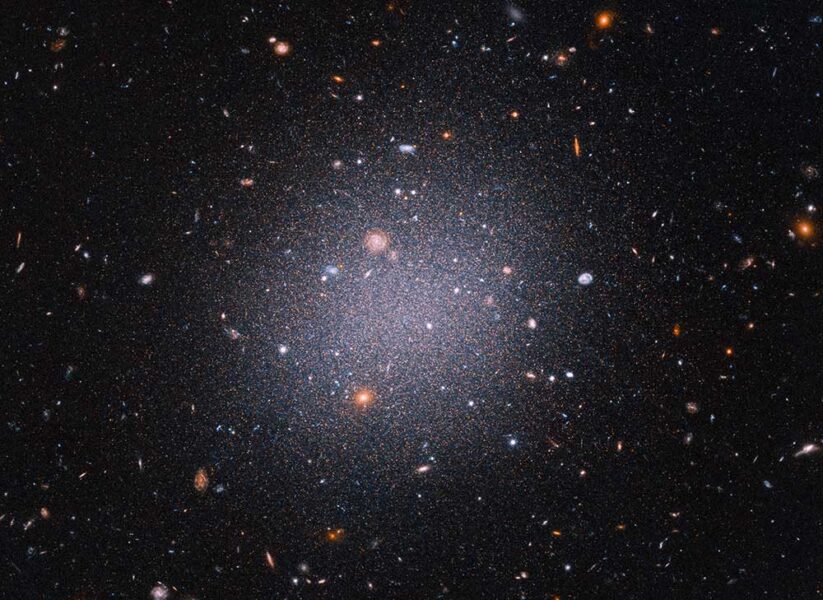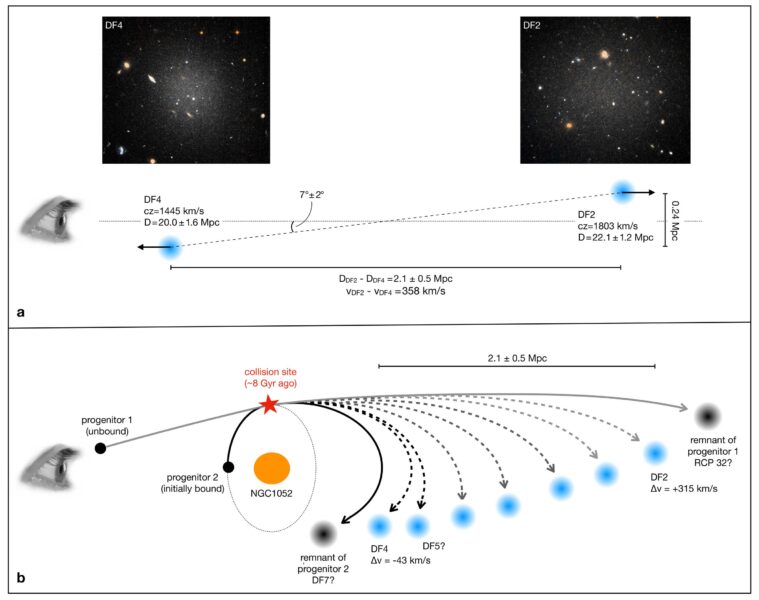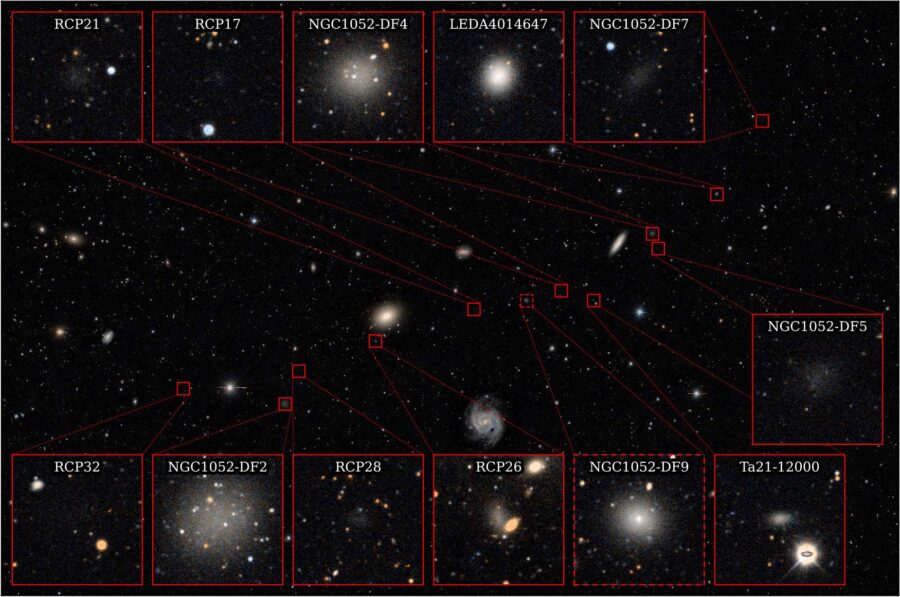Astronomers connect the dots between two strange doppelganger galaxies, uncovering what might be a string of galactic pearls created in a cosmic collision 8 billion years ago.

Pieter van Dokkum et al. / Nature 2022
In 2018 and 2019, a team led by Pieter van Dokkum (Yale University) reported the discovery of two dwarf galaxies (named DF2 and DF4) that appeared to be devoid of dark matter. The announcement puzzled astronomers, because dark matter is thought to provide the gravitational tug ordinary matter needs to form galaxies. Dark matter–deficient galaxies don’t seem to follow that playbook.
Heated discussions ensued, as some others suggested that perhaps the distances to the galaxies had been measured incorrectly. But amid the controversy, what went relatively unnoticed was just how alike DF2 and DF4 really are. They are similar in size, luminosity, morphology, and velocity dispersion, and both contain a peculiar population of very luminous globular clusters. Crucially, assuming the distances are correct, they are also thought to lie in the same neighborhood: the region around a bright elliptical galaxy known as NGC 1052.
Twins Born in a Galactic Collision
In the May 19th Nature, van Dokkum’s team asks whether DF2 and DF4 are more than just doppelgangers. Might they be twins born of the same cosmic mother? “I started out with this assumption that it is very unlikely these galaxies have nothing to do with one another,” says van Dokkum. “They are both unique in the universe, except for their twin, which happens to live in the same group.”
Early in the analysis, the researchers clocked the two galaxies as running away from each other at high speeds. Using their present-day line-of-sight positions and velocities, and DF2’s estimated age, the team traced their positions back in time to a common origin. Then, taking into account the galaxies’ peculiar properties, the team constructed a scenario for their formation, based on previous computer simulations.

P. van Dokkum (Yale University)
In this scenario, a satellite galaxy of NGC 1052 collided with another unbound galaxy some 8 billion years ago. The stars and dark matter involved slipped past one other, interacting only weakly through gravity. But the high-speed collision compressed and slowed down the galaxies’ gas.
“The gas got strung out into a whole bunch of clumps that then, under their own gravity, collapsed and formed new galaxies without dark matter, because the dark matter got lost,” explains van Dokkum. Under this origin story, other dark matter–deficient galaxies could be visible in the vicinity, forming a line between DF2 and DF4 like a string of pearls. And what of the dark matter–dominated remnants of the two galaxies? They might lie at the ends of the string.
The team searched the catalog of galaxies around NGC 1052 and found 11 lined up as predicted, including DF2 and DF4. At the far ends, beyond DF2 and DF4, are two peculiar galaxies: RCP 32 and DF7. These could be the missing relics of the original collision.

P. van Dokkum (Yale University)
Although van Dokkum acknowledges the ancestral identity of RCP 32 and DF7 is somewhat speculative, he feels the observed string of pearls shows that these galaxies, barring a few potential interlopers, are at least related in some way and could share a common origin.
Cosmic Alignment or Happenstance?
“The new results offer a very interesting and neat scenario to explain the low/null dark matter content of DF2 and DF4,” says Pavel Mancera Piña (ASTRON and University of Groningen, The Netherlands) who was not involved in the study. Piña has uncovered a further six dark matter–deficient galaxy candidates, albeit with properties different from DF2 and DF4. “I think we will be able to say something with more certainty once the distance, radial velocities, and total mass of more galaxies near the trail of DF2 and DF4 are obtained.”
Michelle Collins (University of Surrey, UK) is similarly cautious. “For me, it comes across as a nice idea, but with a number of significant issues,” she says. “One is that they assume these 11 systems in a line are all associated to NGC 1052.”
According to their positions on the sky, the line of 11 dwarf galaxies sits near three other large galaxies. The spiral NGC 1035, for example, is nestled directly on the path but is much closer to us than NGC 1052. Given that another group has claimed that NGC 1035 is pulling on DF4, Collins would have liked to have seen additional analysis incorporating the potential influence of these other large galaxies “to convince people that it's not just a chance line-of-sight overlap, kind-of like a constellation.”
What Collins, Mancera Piña, and van Dokkum do agree on is that the collision scenario proposed to explain how DF2 and DF4 formed is, in principle, easily tested. Van Dokkum’s team intends to point an army of powerful telescopes at these 11 galaxies to settle the issue once and for all.
Ground-based instruments such as the Very Large Telescope in Chile and the Keck Telescope on Mauna Kea, Hawai‘i, will measure the galaxies’ radial velocities. Hubble will take snapshots of each of the 11 galaxies to ascertain whether they are all home to luminous globular clusters like DF2 and DF4, and van Dokkum has applied for extra time on the venerable space telescope to measure the galaxies’ distances, too.
Finally, van Dokkum hopes to obtain time on the James Webb Space Telescope to measure the masses of the two galaxies RCP 32 and DF7 at the far ends of the galactic string of pearls: “That's kind of the Holy Grail because then we might find where the dark matter is in this whole system.”
 0
0









Comments
You must be logged in to post a comment.